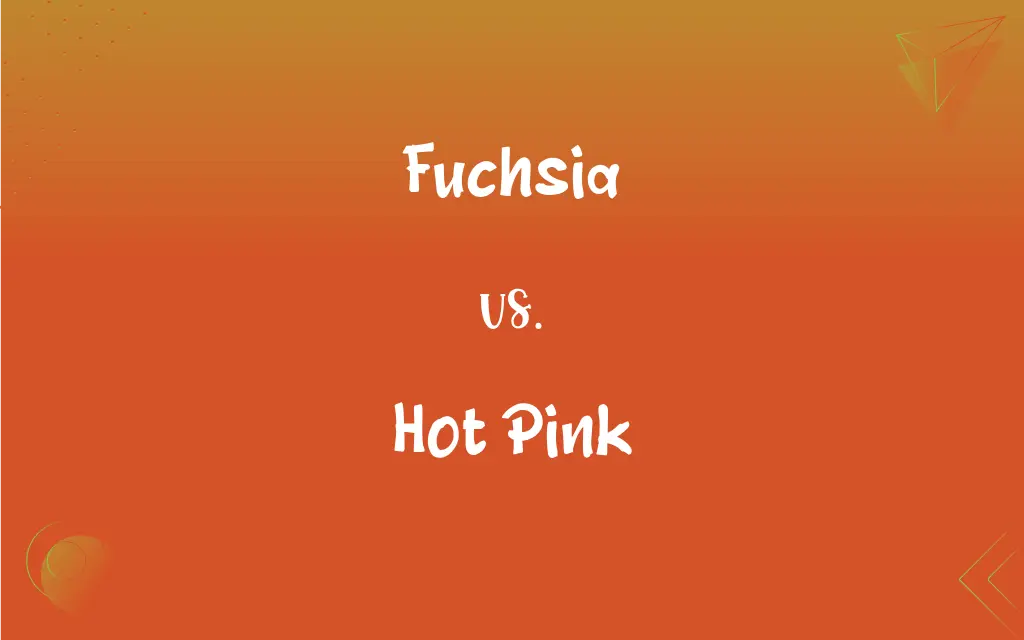Fuchsia vs. Hot Pink: What's the Difference?
Edited by Aimie Carlson || By Harlon Moss || Updated on July 5, 2024
Fuchsia is a vibrant mix of pink and purple, named after the flower; hot pink is a bright, intense shade of pink.

Key Differences
Fuchsia, as a color, is a dynamic blend of pink and purple, often reflecting more purple undertones. Hot pink, on the other hand, is a shade of pink that stands out because of its intensity and vibrancy, often without the presence of any purple hints.
Fuchsia derives its name from the fuchsia plant, known for its distinct, beautiful flowers that are usually a mix of pink and purple. Hot pink does not have such botanical origins and is typically described solely based on its vividness and brightness.
Fuchsia, in its richness, can often be seen as a more sophisticated or mature shade, especially when used in fashion or design. Hot pink tends to convey more energy, youthfulness, and playfulness, making it a favorite for bold statements.
Fuchsia's depth and mix of colors can sometimes make it a slightly more subdued shade when compared to the pure brightness of hot pink. Meanwhile, hot pink is often associated with passion, excitement, and attention-grabbing scenarios because of its undeniable pop.
When we look at their presence in nature, fuchsia often reminds one of the delicate yet vibrant shades found in various flowers. Hot pink, with its almost neon quality, can seem more artificial, though it is still seen in some natural settings like sunsets or certain flowers.
ADVERTISEMENT
Comparison Chart
Primary Shade
Mix of pink and purple
Intense shade of pink
Origin of Name
Named after the fuchsia plant
Descriptive, based on brightness
Connotation
Sophisticated, mature
Youthful, playful
Intensity
Vibrant but can be subdued
Extremely bright and attention-grabbing
Presence in Nature
Common in flowers
Less common, but seen in sunsets or specific flowers
ADVERTISEMENT
Fuchsia and Hot Pink Definitions
Fuchsia
Fuchsia often contains noticeable purple undertones.
The fuchsia scarf had hints of purple that complemented her outfit.
Hot Pink
Hot pink is a bright and intense shade of pink.
The hot pink balloons were visible from a distance.
Fuchsia
Fuchsia can be seen as a sophisticated shade in design.
The fuchsia accents in the room gave it an elegant touch.
Hot Pink
Hot pink is often associated with bold and attention-grabbing scenarios.
The hot pink signage ensured that the store got noticed.
Fuchsia
Fuchsia is named after the flowering plant of the same name.
The garden was filled with the vibrant color of fuchsia flowers.
Hot Pink
Hot pink conveys energy and youthfulness.
Her hot pink sneakers were perfect for the dance party.
Fuchsia
Fuchsia is a vivid blend of pink and purple.
Her fuchsia dress stood out at the party.
Hot Pink
Hot pink lacks the purple undertones seen in fuchsia.
The hot pink lipstick was a pure shade without any hints of purple.
Fuchsia
Fuchsia is a natural color often found in botany.
The petals of some flowers exhibit a stunning fuchsia hue.
Hot Pink
Hot pink, due to its vibrancy, is often used for impactful statements.
The ad campaign used hot pink to capture the audience's attention immediately.
Fuchsia
Any of various tropical shrubs or trees of the genus Fuchsia, widely cultivated for their showy, drooping, purplish, reddish, or white flowers.
FAQs
Which color is more mature, fuchsia or hot pink?
Fuchsia is often seen as more sophisticated or mature.
How can one describe hot pink?
Hot pink is a bright, intense shade of pink.
Does fuchsia always contain purple undertones?
Fuchsia typically has noticeable purple undertones.
What colors make up fuchsia?
Fuchsia is a blend of pink and purple.
How are fuchsia and hot pink different in digital design?
In digital design, fuchsia might be used for a more elegant feel, while hot pink can provide a pop of color.
From where does fuchsia get its name?
Fuchsia is named after the fuchsia plant with similarly colored flowers.
Which color, fuchsia or hot pink, is more attention-grabbing?
Hot pink, due to its brightness, is typically more attention-grabbing.
Is hot pink derived from a natural source?
The term "hot pink" is descriptive and doesn't have botanical origins like fuchsia.
How does hot pink typically make one feel?
Hot pink conveys energy, youthfulness, and playfulness.
Does hot pink symbolize passion?
Yes, hot pink often represents passion and excitement.
Is hot pink closer to neon pink?
Yes, hot pink often has a neon-like brightness and intensity.
Can fuchsia be used as an alternative to purple?
While fuchsia has purple undertones, it's distinct and not a direct alternative to purple.
Can fuchsia be considered a shade of pink?
Yes, fuchsia can be considered a shade of pink with purple undertones.
What emotions does hot pink evoke?
Hot pink often evokes feelings of fun, energy, and vibrancy.
Which color is more vibrant, fuchsia or hot pink?
Hot pink is typically brighter, while fuchsia can be more subdued.
Is fuchsia considered a warm or cool color?
Fuchsia, with its mix of pink and purple, can be seen as a warm color with cool undertones.
Which industries prefer to use hot pink for branding?
Industries targeting younger audiences or wanting to make bold statements might favor hot pink.
Is hot pink a natural color?
While hot pink can seem artificial, it is seen in some natural settings like sunsets.
Are both fuchsia and hot pink popular in fashion?
Yes, both colors have their own popularity in fashion, with fuchsia being elegant and hot pink being bold.
Is fuchsia common in floral arrangements?
Yes, fuchsia is a common shade in many flowers and floral arrangements.
About Author
Written by
Harlon MossHarlon is a seasoned quality moderator and accomplished content writer for Difference Wiki. An alumnus of the prestigious University of California, he earned his degree in Computer Science. Leveraging his academic background, Harlon brings a meticulous and informed perspective to his work, ensuring content accuracy and excellence.
Edited by
Aimie CarlsonAimie Carlson, holding a master's degree in English literature, is a fervent English language enthusiast. She lends her writing talents to Difference Wiki, a prominent website that specializes in comparisons, offering readers insightful analyses that both captivate and inform.
































































